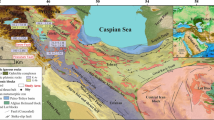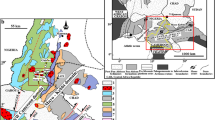Abstract
Mesozoic maximum horizontal stress (σ H max) directions are determined from healed microcracks and the secondary fluid inclusions within healed microcracks in granites from the Inje, Jecheon, Wolaksan and Sokrisan areas. The strike of healed microcracks in granite from the Inje area shows a strong peak at N50°W, while N10°W and N80°E are well developed as secondary and the tertiary peaks, respectively. N30°W is the most dominant strike direction of healed microcracks in granites from the Jecheon area, while E-W is the second most dominant strike direction. Orientations of healed microcracks in granite from the Wolaksan area show a strong peak trend of N55°W, while the secondary peak is at N5°E. The most dominant strike direction of healed microcracks in granites from the Sokrisan area is N-S. The age for the formation of healed microcracks is determined from homogenization temperatures of fluid inclusion and the cooling history of granites. The age of healed microcrack formations in the Jecheon granite might be 207∼149 Ma, 176∼160 Ma in the Inje granite, 116∼88 Ma in the Wolaksan granite and 92∼84 Ma in the Sokrisan granite. In addition, the age of the NW-SE healed microcrack in the Wolaksan granite is 95 Ma, and that of the N-S healed microcracks in the Wolaksan and Sokrisan granites is 100∼84 Ma and 92∼84 Ma, respectively. This means that the rotation of principal stress axes occurred at 100∼95 Ma. The σ Hmax direction in the Korean peninsula was NW-SE in the Late Triassic to Early Cretaceous times, but changed to N-S in the Late Cretaceous. The directions and ages for the formation of healed microcracks in the study area are well correlated with Mesozoic tectonism in South Korea, that is, the Daebo orogeny in the Jurassic∼Early Cretaceous with the σ H max direction of NW-SE mainly having an effect on the Jecheon, the Inje and the Wolaksan granite, and the Middle∼Late Cretaceous Bulguksa tectonic event with the σ Hmax direction of N-S mainly having an effect on the Sokrisan granite.
Similar content being viewed by others
References
Boullier, A.M., 1999, Fluid inclusions: tectonic indicators. Journal of Structural Geology, 21, 1229–1235.
Chough, S.K., Kwon, S.T., Ree, J.H., and Choi, D.K., 2000, Tectonic and sedimentary evolution of the Korean peninsula: a review and new view. Earth-Science Reviews, 52, 175–235.
Cluzel, D., 1988, The Honam Shear Zone (S. Korea): A major rate Triassic dextral ductile fault. In: International Symposium on Evolution of the Eastern Eurasian Margin, Paris, France, p. 42.
Cluzel, D., 1992, Ordovician bimodal magmatism in the Ogcheon belt (South Korea): Intercontinental rift-related volcanic activity. Journal of Southeast Asian Earth Science, 7, 95–209.
Cluzel, D., Cadet, J.P., and Lapierre, H., 1990, Geodynamics of the Ogcheon belt (South Korea). Tectonophysics, 183, 41–56.
Cluzel, D., Lee, B.J., and Cadet, J., 1991, Early middle Paleozoic intraplate orogeny in the Ogcheon Belt (South Korea): A new insight on the Paleozoic buildup of East Asia. Tectonics, 10, 1130–1151.
Frerich, J.T. and Wong, T.F., 1986, Micromechanics of thermally induced cracking in three crustal rocks. Journal of Geophysical Research, 91, 12743–12754.
Gerla, P.J., 1988, Stress and fracture evolution in a cooling pluton: An example from the Diamond Joe Stock, west Arizona, U.S.A., Journal of Volcanology and Geothermal Research, 34, 267–282.
Jang, B.A., 1991, Numerical Modeling of healed crack orientations in granite. Journal of Geological Society of Korea, 27, 319–329.
Jang, B.A., 1992, Characteristics of healed microcracks in granite based on numerical modeling. Journal of Geological Society of Korea, 28, 458–470.
Jang, B.A. and Wang, H.F., 1991, Micromechanical modeling of healed crack orientations as a paleostress indicator: Application to Precambrian granite from Illinois and Wisconsin. Journal of Geophysical Research, 96, 19655–19664.
Jang, B.A., Wang, H.F., Ren, X., and Kowallis, B.J., 1989, Precambrian paleostress from microcracks and fluid inclusions in the Wolf River batholith of central Wisconsin. Geological Society of America Bulletin, 101, 1457–1464.
Jeong, H.S. and Jang, B.A., 2004, Mesozoic paleostress from healed microckracks and fluid inclusions of the Yeongju granite in the Sobaegsan massif. Journal of the Geological Society of Korea, 40, 179–190.
Jang, B.A. and Jeong, H.S., 2005, Cretaceous and Tertiary paleostress from healed microckracks and fluid inclusions of granites in Masan and Yangsan areas. Journal of the Geological Society of Korea, 41, 59–72.
Jin, M.S., 1995, Geochronology and cooling history of the Mesozoic granite plutons in the central part of the Ogcheon Fold Belt, South Korea. Journal of Petrological Society of Korea, 4, 153–167.
Jin, M.S., Kim, S.J., Shin, S.C., Choo, S.H., and Chi, S.J., 1992. Thermal history of the Jecheon granite pluton in the Ogcheon Fold Belt, South Korea. Journal of Petrological Society of Korea, 1, 49–57.
Jwa, Y., Nakajima, T., Uchiumi, S., and Shibata, K., 1990, Geochronology and cooling history of Mesozoic granitic rocks in the Inje-Hongcheon district, South Korea. Geochemical Journal, 24, 93–103.
Kang, P.C., 1979a, Geological analysis of Landsat imaginary of South Korea (I). Journal of Geological Society of Korea, 15, 109–126.
Kang, P.C., 1979b, Geological analysis of Landsat imaginary of South Korea (II). Journal of Geological Society of Korea, 15, 181–191.
Kang, S.S., Kim, J.M., and Jang, B.A., 2005. Paleostress fields from calcite twins in the Pyeongan Supergroup, South Korea. The Island Arc, 14, 137–149.
Kihm, Y.H. and Kim, J.H., 2003, Structural characteristics of the central Ogcheon Belt, South Korea: Orogen-parallel tectonic transport model. Journal of Asian Earth Sciences, 22, 41–57.
Kim, J.H., 1996, Mesozoic tectonics in Korea. Journal of Southeast Asian Earth Sciences, 13, 251–265.
Kim, J.H., Koh, H.J., and Kee, W.S., 1989, The Okdong fault. Journal of Korean Institute of Mining Geology, 22, 285–291.
Kim, J.H., Lee, J.Y., Nam, K.H., and Choi, P.Y., 1992, Paleostress analysis within the thrust zone, Yeongchun, the Danyang coalfield, Korea. Journal of the Geological Society of Korea, 28, 184–195.
Kim, J.M., Jang, B.A., Obara, Y., and Kang, S.S., 2008, Paleostress reconstructions based on calcite tiwns in the Joseon Supergroup, northeastern Ogcheon Belt (South Korea). The Island Arc, 17, 57–69.
Kim, O.J., 1971, Study on the intrusion epochs of younger granites and their bearing to orogenesis in South Korea. Journal of Korean Institute of Mining Geology, 5, 231–240.
Knapp, B.B. and Knight, J.E., 1977, Differential thermal expansion of pore fluids: Fracture propagation and microearthquake production in hot pluton environment. Journal of Geophysical Research, 82, 2515–2522.
Koh, H.J., 1995, Structural analysis and tectonic evolution of the Ogcheon Supergroup, Goesan, central part of the Ogcheon belt, Korea. Ph.D. thesis, Seoul National University, Seoul, 282 p.
Kowallis, B.J., Wang, H.F., and Jang, B.A., 1987, Healed microcrack orientations in granite from Illinois borehole UPH-3 and their relationship to the rock’s stress history. Tectonophysics, 135, 297–306.
Kranz, R.L., 1983, Microcracks in rocks: A review. Tectonophysics, 100, 449–480.
Lespinasse, M. and Pêcher, A., 1986, Microfracturing and regional stress field: a study of the preferred orientations of fluid-inclusion planes in a granite from the Massif Central, France. Journal of Structural Geology, 8, 169–180.
Mawer, C.K. and Williams, P.F., 1985, Crystalline rocks as possible paleoseismicity indicators. Geology, 13, 100–102.
Nur, A. and Simmons, G., 1970, The origin of small cracks in igneous rocks. International Journal of Rock Mechanics and Mining Sciences & Geomechanics Abstract, 7, 307–314.
Pêcher, A., Lespinasse, M., and Leroy, J., 1985, Relations between fluid inclusion trails and regional stress field: a tool for fluid chronology — an example of an intragranitic uranium ore deposit (northwest Massif Central, France). Lithos, 18, 229–237.
Plumb, R., Engelder, T., and Yale, D., 1984, Near-surface in situ stress: 3. Correlation with microcrack fabric within the New Hampshire granite. Journal of Geophysical Research, 89, 9350–9364.
Potter, R.W. II, 1977, Pressure corrections for fluid-inclusion homogenization temperature based on the volumetric properties of the system NaCl-H2O. Journal of Research of the U.S. Geological Survey, 5, 603–607.
Ren, X., Kowallis, B.J., and Best, M.G., 1989, Paleostress history of the Basin and Range province in western Utah and eastern Nevada from healed microfracture orientations in granites. Geology, 17, 487–490.
Roedder, E., 1984, Fluid inclusions. Reviews in mineralogy 12. Mineralogical Society of America, Washington, D.C., 645 p.
Schild, M., Vollbrecht, A., Siegesmund, S., and Reutel, Chr., 1998, Microcrakcs in granite cores from the EPS-1 geothermal drill hole, Soultz-sous-Forêts (France): paleostress directions, paleofluids and crack-related Vp-anisotropies. Geol Rundsch, 86, 775–785.
Tuttle, O.F., 1949, Structural petrology of planes of liquid inclusions. Journal of Geology, 57, 331–356.
Author information
Authors and Affiliations
Corresponding author
Rights and permissions
About this article
Cite this article
Jang, BA., Kang, SS. Mesozoic paleostress from healed microcracks and fluid inclusions in some granites of South Korea. Geosci J 15, 161–175 (2011). https://doi.org/10.1007/s12303-011-0011-2
Received:
Accepted:
Published:
Issue Date:
DOI: https://doi.org/10.1007/s12303-011-0011-2




